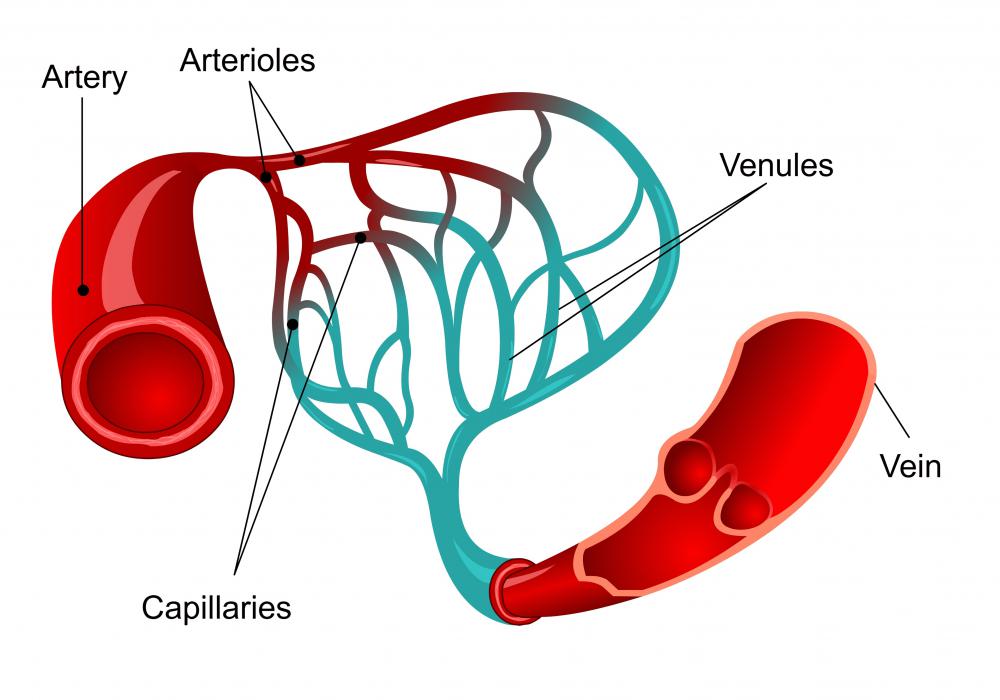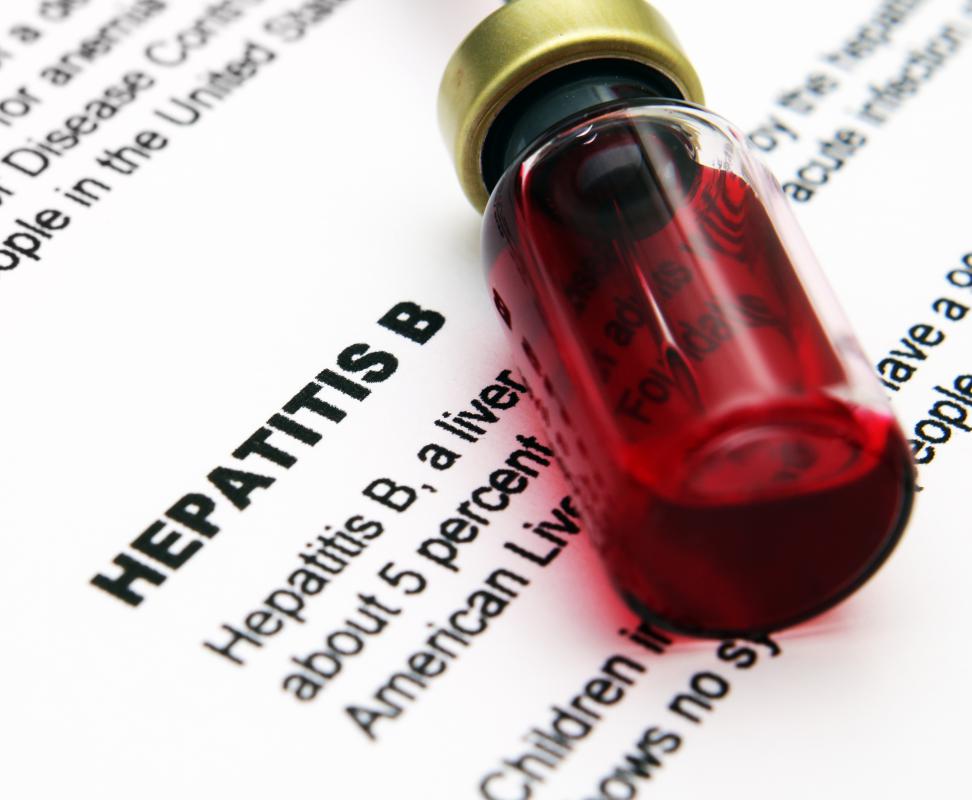At TheHealthBoard, we're committed to delivering accurate, trustworthy information. Our expert-authored content is rigorously fact-checked and sourced from credible authorities. Discover how we uphold the highest standards in providing you with reliable knowledge.
What is Cutaneous Vasculitis?
Cutaneous vasculitis is the inflammation of blood vessels in the skin. It particularly affects small and medium-sized blood vessels, such as the arterioles, capillaries and venules. Arterioles are small arteries or blood vessels carrying oxygenated blood from the heart to other parts of the body. Capillaries are very tiny blood vessels that connect the veins to the arteries. Venules are small veins that are mostly responsible in transporting unoxygenated blood towards the heart.
There are several characteristic symptoms of cutaneous vasculitis. A rash is frequently seen in the skin surface, forming small red blotches known as petechiae or large bruises known as ecchymosis. Other manifestations of the disorder are macules and papules, which are wheal or lump formations in the skin. Patients may also present with fever, swelling of the lower legs, redness, and pruritus or itching.

This condition is usually self-limiting, with symptoms resolving within two weeks to several months, depending on the severity of the inflammation. Infection is commonly the cause of this condition, but it can also be caused by certain cancers, autoimmune diseases, and hypersensitivity or allergy to drugs. Autoimmune diseases are caused by an abnormal response of the body to its own cells. One example is rheumatoid arthritis (RA), is a condition manifested by chronic inflammations mostly of the joints, but may also involve the skin and blood vessels.

Cutaneous vasculitis can be divided into three kinds: acute, subacute and chronic. An acute case can be alarming because of the damage it does in the tissues and the affected blood vessels. When blood vessels are inflamed, it can obstruct the blood supply to the surrounding tissues and result in tissue death. This is often triggered by infection.
Subacute cases are less serious and usually resolve in just a week. Typically, small petechiae are evident and are accompanied by flushing or warm sensations in the affected limb. Chronic vasculitis usually forms macules and papules in areas of the body where blood vessels are dominant. This is related to chronic infections such as hepatitis B, which is a viral infection.

Diagnostic tests are used to determine the underlying disease involved that precipitated this condition, and urine and blood tests are usually requested to rule out any infection. After confirming the cause, medications are often prescribed to treat the underlying condition and to relieve the symptoms. Outlook for patients with cutaneous vasculitis is generally favorable because treatment is readily available and complications are not likely to occur.
AS FEATURED ON:
AS FEATURED ON:
















Discussion Comments
I was evaluated for similar symptoms, like the rash on my legs that was red. The dermatologist took one glance at it and said it was Schambergs Disease, not this vasculitis issue that is so concerning and that there really isn't much that can be done for it unless it gets really itchy.
I just wanted to share the possibility that Schambergs might be what people are dealing with instead of vasculitis.
Recently I started developing a nasty rash. It would start with skin swelling (which is normally noticed by me because when I swell I itch), then the bumps formed, which later I learned were uticaria (hives).
After seeing an allergenist, I discovered the reason was from a medicated I stopped taking two months ago (Zoloft a.k.a. sertraline - an anti-depressant).
I am still experiencing the itching, swelling and hives, but have not been told how long to expect this to happen for. I hope it doesn't take too much longer for any residual medication to pass through my system.
This article was very helpful for me to understand my diagnosis. Thank you.
@epiphany5 - I am sorry that you had to wait so long before you could be treated for your cutaneous vasculitis. I had to go through a similar situation, since I too was uninsured for about seven months.
I developed purple bumps on the inside of my arms, and I immediately went to the emergency room. I do not take any chances when it comes to my health, so I did not mind waiting for four hours to see a doctor.
After my blood and urine were tested, the doctor called me back to say that I was having a reaction to some birth control pills I was taking. He said that it was a good thing that I came in right after I saw the symptoms, because if I had waited longer, the reaction could have done some serious damage to my vascular system.
Thank you to the author for posting this. It was pretty easy to follow along.
I am currently a medical school student, and I really appreciate you writing this article. I will pass it along to some of my classmates.
My dream is to become a cardiologist, so I especially appreciated how you tied in cutaneous vasculities with terms like capillaries and arterioles.
One thing I would like to add though is a possible treatment for cutaneous vasculities. The best treatment that I have seen used on patients is a dose of corticosteroids. I will spare the readers out there of the details of what exactly this medicine is. But if a patient has a mild to severe cutaneous vasculities, then corticosteroids should do the trick in clearing up the skin.
Sorry for my rambling, but I love talking about medicine!
I started to develop patches of red dots on my feet. I did not know what it was, but I did not have health insurance at the time so I did not go to a doctor to get it checked out. I was in between jobs.
Once I got a new job with health benefits, I immediately went to the doctor, since the red dots had spread to my ankles. The doctor took a urine and blood sample to see if the dots were caused by any infection or autoimmune disease.
Turns out that all those little red dots were cutaneous vasculitis, and the cause was lupus.
Lupus is a disease for which there is no cure for, so I was at first scared for my life. The doctor was kind enough to introduce me to some support groups, so I am coping with it a lot better now. It has been around four years since my diagnosis.
I can go on talking about lupus, but that is not what this article is about. I will just end by saying: thanks for writing this, I learned a lot from reading it.
My husband started to have small, but nasty rashes on his body. The mostly occurred between his joints, like on the back of his knees and the inside of his elbows.
I have eczema, so I thought maybe he was having an allergic reaction to something. His rashes looked somewhat similar to the breakouts I get when something triggers my eczema. His rashes, however, were getting worse and they started to spread all down his legs. The color was also turning into a deep red, which is something that my eczema rashes do not do.
We went to the doctor, and they ran some blood and urine test. Turns out he had cutaneous vasculitis. Thankfully, it was not chronic and we caught it early enough. He was having an allergic reaction to a new cholesterol medicine he was taking, so his doctor prescribed another one.
I do not really know much about the condition, so I have been doing some online research. I stumbled across this page, and I am glad that I did. It is very informative. Keep up the good work!
Post your comments